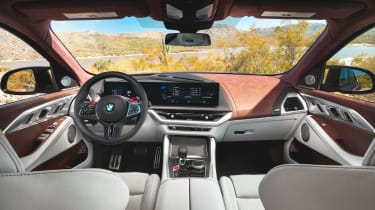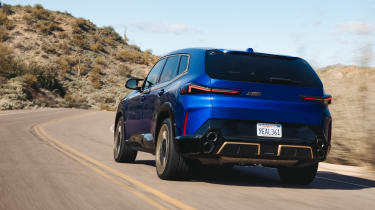New BMW XM 2023 review
Can the new BMW XM plug-in hybrid SUV justify the famous M badge?

Verdict
If you want proof of how hard it is to overcome the laws of physics, it’s right here. The XM might have the technical numbers to live up to its M division badge, and its Marmite looks will (probably) appeal to some as much as they revolt others. But the on-road experience is a world away from anything that’s come before with M; even the likes of the X5 M offer more fun and feel than you’ll find here.
On anywhere but wide, open motorway, the XM’s undeniably potent powertrain and chassis cannot overcome their own complexity, or the sheer size and mass involved, to deliver thrills to match the badge. So the end result is a car that we have to mark up as a rather uninvolving triumph of oneupmanship – perfect for China and the Middle East, but probably best ignored by M devotees in the UK.
Things can’t be easy for performance sub-brands right now. All of the top manufacturers are pushing relentlessly towards electrification and the transitional products are particularly tricky to judge when you’re a cult band of engineers known for additional pace, extra agility and often less weight. We’ve seen Mercedes’ own AMG struggling a little with its latest hybrid C63, and now here comes BMW’s first bespoke M vehicle since the M1: the XM.
Of course, given how the market has evolved, the new arrival isn’t another svelte, low-slung, mid-engined supercar but rather a vast 5.1-metre-long SUV. It’s electrified, too, mixing a 4.4-litre twin-turbo V8 petrol engine (a heavily updated version of the unit seen in the likes of the M5) with an e-motor that can supply up to 192bhp. This plug-in hybrid has a whopping total output of 644bhp and 800Nm, 450Nm of which is available at a standstill – and that’s enough, even in a vehicle weighing more than 2.7 tonnes, for a 0-62mph time of 4.3 seconds and a top speed of up to 168mph if you tick the box for the £2,500 Driver’s Pack.
It can walk the walk on pure-electric power too, with up to 55 miles of range from the 25.7kWh battery – and speeds of up to 87mph. There’s no rapid DC charging but the 7.4kW onboard AC charger can take the battery from zero to 100 per cent in a little over three hours.
Oh, and if these numbers aren’t impressive enough for you, BMW has made the unusual move of confirming that an even more potent edition, called Label Red, will appear later this year, equipped with an uprated powertrain producing 738bhp and 1,000Nm of torque. It’ll crack 0-62mph in less than four seconds, we’re told.
We’re not here to judge a vehicle’s looks but it is safe to say that the XM has the sort of design that’s likely to polarise opinion. At the front, ultra-slim headlights sit above an enormous take on the double-kidney grille. Not a single panel along the flanks goes uncreased and at the rear, there’s further complex surfacing and a pair of twin vertically stacked exhaust tips.
BMW doesn’t appear to be shy in playing around with colour and trim either, so if you want, you can match gloss-black trim with bright red paint, or pair gold highlights with a dark-blue finish. The XM is certainly a statement vehicle – and these traits, along with the sheer size of the thing (it’s more than two metres wide), are probably why the UK doesn’t feature in the list of its five key markets, which include China, the United States and the Middle East.
Regardless of where it is in the world, though, the XM is being pitched as an M car, so it has to deliver something of the division’s DNA on the road – in the same way that a Bentayga somehow still feels like a Bentley, or Porsche’s Cayenne Turbo S can sit alongside a 911 in the garage without a whiff of embarrassment.
Upon start-up, the XM eschews the usual theatre of a rumbling exhaust note and instead celebrates the electric part of the powertrain. So the first thing you hear is a subtle sci-fi whoosh, sourced from ace composer Hans Zimmer. We haven’t even moved beyond a standstill and this is already a significant departure for M division.
Still, the engineers certainly haven’t held back on more conventional tech when attempting to deliver on-road thrills. The four-wheel drive system has adjustable amounts of rear bias; the chassis gets electronically controlled dampers and 48v active anti-roll bars; the brake system has two pedal-feel settings; there’s an M Sport rear differential, along with rear-wheel steering; the electric power steering itself is speed sensitive and has a variable ratio, the first time this combo has been offered on an M model.
What this arsenal of tricks fails to do, in our experience on roads in Arizona, is deliver anything approaching involvement. There’s no denying the amount of shove here – the electric motor is integrated into the gearbox, and the 450Nm available from rest has the XM jumping forwards if you prod the throttle; it’s best to adopt a delicate approach when pulling away.
Sadly, much of what comes after that point is a demonstration of how darned hard it is to nail down the transitions of a hybrid system. Regardless of how you set up the XM’s countless configuration options for throttle map, braking feel, energy recuperation and so forth, if you find yourself on the right bit of road, you’re likely to be disappointed. It just feels like a car that’s constantly trying to second guess the situation and react accordingly, instead of one that has the purity of focus, role and technology to be on your side the whole time.
The control weights are hard to read in a manner that just isn’t common on conventionally powered M cars. In its Sport setting, the steering response around the straight ahead is almost comically rapid; the brake pedal feels either soft, requiring faith on the driver’s part as it moves from energy recuperation through to discs and pads, or slightly grabby. And when you really demand performance with a heavy stamp on the right-hand pedal, the system struggles to blend petrol power into that initial electric-motor surge without a noticeable kick.
The XM does a decent job of staying flat and controlled in longer, sweeping corners, but it struggles to get out of its own way in the twisty stuff. This is particularly true if you’re trying to hustle it, when the powertrain’s foibles can unsettle the rest of the package as you try to accelerate out of tighter turns. And the trade-off for that body control is a ride that is too keen to pick up road imperfections at lower speeds, and transmit them through to the cabin. It never becomes genuinely crashy or uncomfortable, but it struggles to dial out patter, especially on larger wheels like our test vehicle’s 22-inch items (21-inchers are standard).
Through all of this, the XM’s V8 can deliver a pleasing NASCAR-esque thudding note over the bulk of its range, but it does sound a little thinner and more strained at higher revs, instead of being a true screamer. And accompanying Zimmer sound effects, designed to showcase how petrol power is being boosted by electricity, are more wearing than the EV-mode hum.
The XM’s natural habitat then, as far as we can ascertain from all of this, is the autobahn, where its raw power can be fully deployed, taking you to three-figure cruises in imposing (but gradual) fashion as the ride just about settles down, the body control remains solid and the powertrain fades into the background. But frankly, if you’re sitting at the wheel of an XM on a motorway, fiddling with the minutiae of the car’s dynamics settings on the central display and telling yourself that you’re somehow immersed in the type of experience that has defined M cars for half a century, you’re living a lie.
At least you’ll be able to take comfort from the honesty of what’s around you, because the cabin is a pretty special place. It’s perhaps little more snug up front than you might expect, thanks to huge door inserts and a dashboard that extends a long way in from the base of the windscreen. It’s dominated, too, by BMW’s dual-screen instrument panel (12.3 inches) and infotainment (14.9 inches) set-up, running what remains one of the best interfaces in the business.
There’s no doubt that the rear ‘M lounge’ cabin is impressive, with plush seats and acres of legroom and headroom. It’s all beautifully built and the variety of materials and finishes on offer is staggering; our test vehicle had an intricate headlining featuring a 3D block pattern, unlike anything we’ve seen on a car before, and you could also spec coffee-brown ‘vintage’ leather, on key areas like the dash and door inlays, that’s been treated to highlight its unique natural imperfections.
The boot capacity is generous, at 527 litres or 1,820 litres if you fold down the 40:20:40-split rear seat. There’s no load lip to bother you, but it’s worth pointing out that the opening itself is a fair way up from ground level if you’re planning to heave heavy items into place. There’s no underfloor storage either, so a chunk of the load bay will potentially be taken up by the charging cable, stored though it is in an exclusive holdall designed to look like posh luggage.
That add-on is perhaps a telling reflection of how, for all its complexity, the XM feels more of a tech-laden luxury goods item than a true M model. BMW clearly sees this car as a step up from anything else in the range – and the prices reflect that. The starting figure is an eye-watering £148,060, making this, by some way, the most expensive series-production model in the company’s history, and catapulting it dangerously close to the Lamborghini Urus and Bentley Bentayga.
|
Model |
BMW XM |
|
Price |
£148,060 |
|
Drivetrain |
4.4-litre twin-turbo V8 petrol, 1x e-motor |
|
Power/torque |
483bhp/800Nm |
|
Transmission |
Eight-speed automatic, four-wheel drive |
|
0-62mph |
4.3 seconds |
|
Top speed |
168mph (Driver’s Pack) |
|
Economy/CO2 |
176.5-188.3mpg / 36-33g/km |
|
EV range |
51-55 miles |
|
On sale |
Now |













